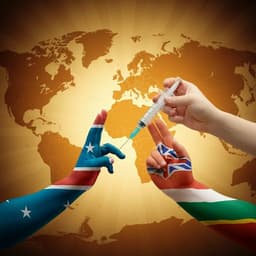
Political Science
Media debates about China's role as a global public goods supplier: frame contestation in reporting on the Chinese COVID-19 vaccine
Y. Yi, H. Liu, et al.
Explore how Chinese media frames its COVID-19 vaccine as a global public good and how Western media responds with skepticism. This insightful research by Yan Yi, Huimin Liu, and Yifan Yang uncovers the underlying tensions of great power competition and the implications of China's vaccination diplomacy.
~3 min • Beginner • English
Introduction
The study investigates how China portrayed itself as a global public goods supplier through its COVID-19 vaccine distribution and how the US and Germany perceived this self-projected identity. Positioning media as key agents in constructing international issues, the research explores media framing as strategic international communication in the politicised context of COVID-19 vaccines. It focuses on frame contestation between Chinese and Western media amid great-power rivalry and asks: (1) How do Chinese, US, and German media frame the Chinese vaccine issue? (2) How do these frames compete, and why? (3) How does frame emphasis vary over time (2020 vs. 2021)? The study selects China Daily (CD), the New York Times (NYT), and Die Welt (DW) due to their influence and the intertwined US–EU–China vaccine R&D and business ties (Pfizer/BioNTech/Fosun). Germany serves as a representative EU case given its economic weight and role in EU China policy.
Literature Review
Media framing selects and highlights aspects of issues to shape definitions, causal interpretations, moral evaluations, and treatment recommendations (Entman, 1993). In international communication, frames function as strategic issue positions, influenced by national interests, media routines, and geopolitical contexts (Aalberg et al., 2012; Lee et al., 2002). Prior research shows domestic interests often dominate when international conflicts are involved (e.g., CNN vs. Al Jazeera on ISIS; US vs. Chinese media on the 2018 trade conflict). Framing involves counter-framing and contest to establish dominant narratives (Entman, 2003). The COVID-19 vaccine, while a scientific/health issue, became politicised and a site of US–China competition and vaccine diplomacy. Parallel literature addresses China’s shift from consumer to supplier of global public goods under Xi Jinping, with initiatives like AIIB, BRI, and pandemic aid indicating an identity of a responsible great power (Freeman, 2021). During COVID-19, China pledged vaccines as global public goods and engaged in vaccine diplomacy, while the US initially prioritised domestic vaccination before joining global distribution in mid-2021. US perceptions evolved from promoting a 'responsible stakeholder' narrative to viewing China as a strategic competitor, intensifying narrative battles during the pandemic. Germany/EU present a more nuanced stance: strong economic interdependence with China and hedging between values-based transatlantic ties and pragmatic engagement. Public opinion suggests Europeans are less inclined to view China as a threat and prefer neutrality in US–China conflict. These contexts shape media framing in CD, NYT, and DW.
Methodology
Design: A standardised comparative content analysis using Matthes and Kohring’s (2008) element-based frame identification, grounded in Entman’s four elements: (1) problem definition, (2) causal attribution, (3) moral evaluation, and (4) treatment. Frames are derived by clustering coded elements rather than direct frame coding.
Samples: Articles from the English editions of three national media: China Daily (CD), New York Times (NYT), and Die Welt (DW). Timeframe: 01/26/2020 (CCDC announced vaccine R&D) to 07/01/2021 (China’s 40% vaccination target; WHO global target). Search: 'China + vaccine + Coronavirus or COVID-19' via Lexis Advance; excluded summaries, letters, web/blog duplicates. Final corpus: 355 articles (NYT 142; DW 42; CD 171).
Measures and coding: 36 binary variables (presence=1/absence=0) across the four frame elements captured topics, actors, attributions of benefits/risks (politics, science, media, nonprofits, public, others), benefits/risks across domains (politics, economics, health, collaborations, allocation), and treatment (positive/negative judgement). Two trained coders independently coded all items; mean intercoder agreement=0.84. Variables with frequency>5% were retained for clustering: NYT 32 variables, DW 28, CD 24.
Analysis: Separate hierarchical cluster analyses per outlet (SPSS, Ward’s method); number of clusters determined using the elbow criterion. Comparative framework across outlets, frame elements, and temporal variation (2020 vs 2021).
Key Findings
- China Daily (CD) identified four frames: Global Public Goods (30.99%); Vaccination Promotion (30.41%); Leading Research & Development (28.07%); Global Collaboration (10.53%). CD aligns closely with official discourse, heavily relying on political actors and highlighting vaccines as global public goods and benefits to supply/distribution (e.g., in the Global Public Goods frame, Actor-Politics mean=0.98; benefits to allocation/vaccination mean=0.94). Vaccination Promotion emphasises safety/efficacy with scientific actors frequently quoted. Leading R&D stresses scientific actors/benefit attribution; risks scarcely mentioned across CD frames; treatment is uniformly positive (Judgement: Positive=1.00 across frames). Temporal shift: 2020 emphasised Leading R&D; in 2021 focus moved to Global Collaboration and Vaccination Promotion after market approval on 12/31/2020.
- New York Times (NYT) identified five frames: Safety Risks (38.73%); Vaccine Diplomacy Competition (21.13%); Chinese Threats (16.20%); Global Cooperation (11.97%); Effectiveness Problem (11.97%). Safety Risks dominates, stressing health risks, allocation/vaccination risks, and political actors (e.g., Risks-Health mean=0.95; Risks-Allocation/Vaccination mean=0.91; Actor-Politics mean=0.98; Judgement: Negative mean=0.93). Vaccine Diplomacy Competition highlights strategic rivalry and urges US distribution to counter China. Chinese Threats focuses on R&D-stage competition and portrays Chinese vaccine technology as a political threat. Global Cooperation is the only frame with predominantly positive treatment (Judgement: Positive mean=0.94), acknowledging scientific collaboration and China’s data sharing. Effectiveness Problem questions efficacy and information transparency. Temporal pattern: Safety Risks dominates both years; Chinese Threats and Global Cooperation appear more in 2020; Vaccine Diplomacy Competition and Effectiveness Problem emerge/expand in 2021 as US global distribution ramps up.
- Die Welt (DW) identified two frames: Political Risks (71.4%); Potential Cooperation (28.6%). Political Risks stresses China’s political intentions, vaccine nationalism, and potential threats to the international order, with risks in politics, health, and allocation; coverage mirrors NYT’s scepticism but from a German/EU vantage. Potential Cooperation highlights pragmatic collaboration (e.g., China–Germany R&D/business ties) and benefits to health and global cooperation; affirms scientific collaboration (Benefit attribution: Science=1.00 in this frame). Temporal variation: 2020 saw near parity (10 Political Risks vs. 11 Potential Cooperation articles); in 2021, Political Risks surged (20) while Potential Cooperation nearly vanished (1).
Overall: Across outlets, vaccines were politicised beyond scientific/health agendas. CD promoted a responsible great-power image and public goods provision; NYT and DW foregrounded safety/political risks, with DW somewhat more open to cooperation than NYT. Findings reflect a broader contest between 'China Threat' and 'China Responsibility' narratives.
Discussion
The findings address how national interests and geopolitical competition shape media framing of China’s COVID-19 vaccines. CD’s frames closely mirror state narratives of responsibility, global public goods provision, cooperation, and scientific leadership, aiming to counter Western scepticism. NYT and DW constrain cooperative narratives within broader concerns about safety, efficacy, and geopolitical influence, reflecting strategic competition and domestic political priorities. Germany’s media stance appears relatively softer than the US, allocating notable space to potential cooperation, consistent with German economic interdependence with China and pragmatic policy traditions. Temporal analyses show that as China moved from R&D to distribution and as the US escalated vaccine diplomacy in 2021, Western frames shifted further toward competition and risk, and DW’s cooperative emphasis diminished. These patterns underscore how health issues become arenas for strategic communication, with frame contestation shaping international perceptions of China’s role as a provider of global public goods.
Conclusion
This comparative, standardised content analysis demonstrates that China Daily foregrounds China’s vaccines as global public goods, promoting cooperation and scientific leadership, while NYT and DW predominantly frame Chinese vaccines through safety and political risk lenses. Although cooperative frames exist in Western outlets, they are overshadowed by more negative ones, especially in 2021. Germany’s coverage is relatively more open to cooperation than the US, indicating variation within the West’s response to China’s rising influence. The study contributes empirical evidence of frame contestation around a health topic politicised by great-power rivalry and clarifies how 'China Threat' versus 'China Responsibility' narratives structure international discourse. Future research should examine new media ecosystems and audience responses and broaden European samples to map cross-national variations more comprehensively and to explore how media can facilitate cooperation in providing global public goods.
Limitations
- Media scope: Only three traditional, elite outlets (CD, NYT, DW English) were analysed; findings may not generalise to broader media ecosystems or platforms.
- Platform/audience effects: The study did not examine social/new media dynamics or audience reception, which could shape and amplify frames differently.
- Geographic coverage: European perspectives are represented solely by Germany; inclusion of additional European countries would improve generalisability and nuance.
- Time-bounded analysis: The study ends on 07/01/2021; subsequent developments in vaccines and geopolitics may alter framing patterns.
Related Publications
Explore these studies to deepen your understanding of the subject.







